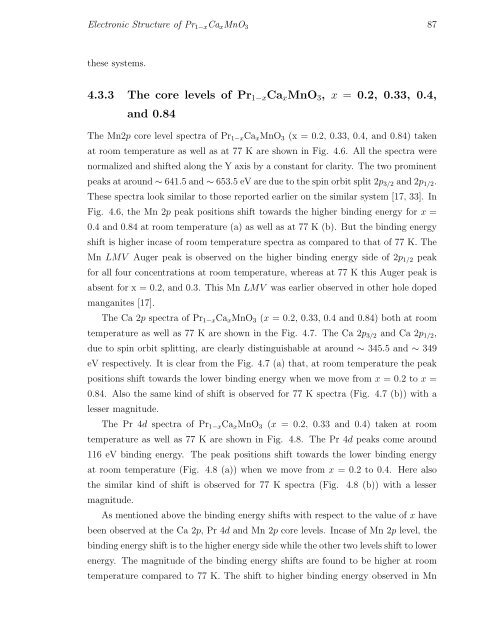PHYS07200604007 Manas Kumar Dala - Homi Bhabha National ...
PHYS07200604007 Manas Kumar Dala - Homi Bhabha National ...
PHYS07200604007 Manas Kumar Dala - Homi Bhabha National ...
You also want an ePaper? Increase the reach of your titles
YUMPU automatically turns print PDFs into web optimized ePapers that Google loves.
Electronic Structure of Pr 1−x Ca x MnO 3 87<br />
these systems.<br />
4.3.3 The core levels of Pr 1−x Ca x MnO 3 , x = 0.2, 0.33, 0.4,<br />
and 0.84<br />
The Mn2p core level spectra of Pr 1−x Ca x MnO 3 (x = 0.2, 0.33, 0.4, and 0.84) taken<br />
at room temperature as well as at 77 K are shown in Fig. 4.6. All the spectra were<br />
normalized and shifted along the Y axis by a constant for clarity. The two prominent<br />
peaks at around ∼ 641.5 and ∼ 653.5 eV are due to the spin orbit split 2p 3/2 and 2p 1/2 .<br />
These spectra look similar to those reported earlier on the similar system [17, 33]. In<br />
Fig. 4.6, the Mn 2p peak positions shift towards the higher binding energy for x =<br />
0.4 and 0.84 at room temperature (a) as well as at 77 K (b). But the binding energy<br />
shift is higher incase of room temperature spectra as compared to that of 77 K. The<br />
Mn LMV Auger peak is observed on the higher binding energy side of 2p 1/2 peak<br />
for all four concentrations at room temperature, whereas at 77 K this Auger peak is<br />
absent for x = 0.2, and 0.3. This Mn LMV was earlier observed in other hole doped<br />
manganites [17].<br />
The Ca 2p spectra of Pr 1−x Ca x MnO 3 (x = 0.2, 0.33, 0.4 and 0.84) both at room<br />
temperature as well as 77 K are shown in the Fig. 4.7. The Ca 2p 3/2 and Ca 2p 1/2 ,<br />
due to spin orbit splitting, are clearly distinguishable at around ∼ 345.5 and ∼ 349<br />
eV respectively. It is clear from the Fig. 4.7 (a) that, at room temperature the peak<br />
positions shift towards the lower binding energy when we move from x = 0.2 to x =<br />
0.84. Also the same kind of shift is observed for 77 K spectra (Fig. 4.7 (b)) with a<br />
lesser magnitude.<br />
The Pr 4d spectra of Pr 1−x Ca x MnO 3 (x = 0.2, 0.33 and 0.4) taken at room<br />
temperature as well as 77 K are shown in Fig. 4.8. The Pr 4d peaks come around<br />
116 eV binding energy. The peak positions shift towards the lower binding energy<br />
at room temperature (Fig. 4.8 (a)) when we move from x = 0.2 to 0.4. Here also<br />
the similar kind of shift is observed for 77 K spectra (Fig. 4.8 (b)) with a lesser<br />
magnitude.<br />
As mentioned above the binding energy shifts with respect to the value of x have<br />
been observed at the Ca 2p, Pr 4d and Mn 2p core levels. Incase of Mn 2p level, the<br />
binding energy shift is to the higher energy side while the other two levels shift to lower<br />
energy. The magnitude of the binding energy shifts are found to be higher at room<br />
temperature compared to 77 K. The shift to higher binding energy observed in Mn
















